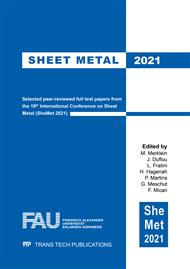p.159
p.167
p.175
p.181
p.189
p.195
p.201
p.209
p.217
Development of Magnetic Field-Assisted Single-Point Incremental Forming
Abstract:
Single Point Incremental Forming (SPIF) has recently introduced the concept of material formability enhancement through localized deformation. Since material is processed by means of a pin tool attached to spindle, physical interference (especially in vertical direction) limits attainable shapes with the conventional process. The aim of the following work is to increase the variety of achievable geometries with SPIF through in-process magnetic field assistance. An innovative configuration managing SPIF tool movement using magnetic force is proposed. With this in mind, a magnet configuration was designed to generate a vertical load able to plastically deform a 0.5 mm thick AA1100 aluminum sheet. Experiments were carried out to prove the concept by manufacturing a truncated cone; the results demonstrated the feasibility of Magnetic Field-Assisted SPIF.
Info:
Periodical:
Pages:
189-194
Citation:
Online since:
April 2021
Authors:
Keywords:
Price:
Сopyright:
© 2021 Trans Tech Publications Ltd. All Rights Reserved
Share:
Citation:


